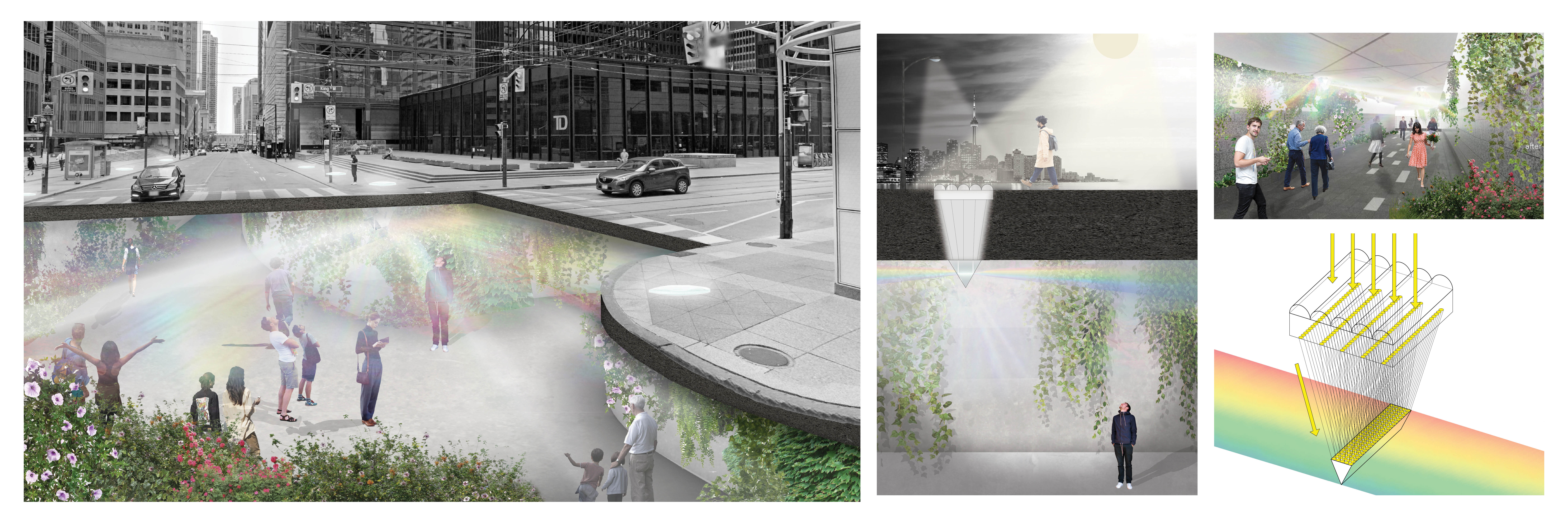Daylight Underground

Category
Daylight investigations - Region 3: The Americas
Students
Dorottya Kiss
Dorottya Kiss
Chanel Chin
School
University of Toronto
Country
Canada
Download
Download ↓
Problem and Solution“Daylight Underground” tackles the dystopian atmosphere of underground pedestrian tunnels. We propose a daylighting system that transports the natural light from the Sun below ground, creating a “walk in nature below the concrete jungle.” We were inspired by the PATH—Toronto’s Downtown Pedestrian Walkway—that connects public buildings through underground pedestrian tunnels, especially used during the Canadian winter when walking above ground in the cold is dangerous for the human body.
“Depression is like a tunnel,” where you always see the light and must keep moving to reach it. We aim to design an underground public space that invites people to spend time and feel connected to nature and to one another, even on days when the weather does not allow them to do so below ground. We want to step away from the conventional tunnels where the goal is solely to pass through as fast as possible to get from one point to another.
Lighting DeviceOur lighting device transports the natural light from the Sun below ground to make it as close to the feeling of sun rays as possible by 1) Maximizing the effectiveness of capturing the sun rays through rectangular-based magnifying glasses instead of circular-based lenses, 2) Concentrates the light flux to the focus points, and 3) Transporting the light for further distances/depths with the use of glass fiber cables.
Light transport systems have three components: collection, transportation, and distribution. 1) We collect the sunlight with Fluorescent Fiber Solar Concentrators, which “consist of an optical fiber solar concentrator with a plate and three-color fluorescent fibers with quantum dots inside them. The coloured molecules absorb the light that is radiated on the plate and re-emit fluorescent radiation which in turn is transported to the edges of the plate by total reflection.” (Nair, Ramamurthy et al. 2014) 2) We transport light through Total Internal Reflection, which “occurs when a ray of light from a denser to rarer medium strikes the medium boundary at an angle greater than the critical angle with respect to the normal to the surface.” (Nair, Ramamurthy et al. 2014) 3) We distribute sunlight with Prismatic Panel Emitters, in which when light passes through, the light bends. As a result, the different colors that make up white light become separated because each color has a particular wavelength and each wavelength bends at a different angle.
When the light enters the magnifying glass, the curvature of the lens intensifies the light rays by concentrating them on a focus line. The magnifying glasses are in a semi-column shape because it aligns the focus points in a straight line, maximizing the use of space. The intensified light ray will be transported to the underground space through the fiber cables, positioned at the focus points of the collecting lens. Placing several of these long lenses creates several focus lines. The glass fiber can transport the light for long distances, nearly eliminating loss due to the complete reflection from the fiber’s inner surface. As the light arrives in the tunnel, prisms disseminate it to the inner surface, scattering it throughout the space.
Our design proposes a different take on channeling daylight than the VELUX Sun Tunnel Skylights. The latter contains a broad tube with a highly reflective inner surface, which acts as a mirroring system with inherently lower effectivity but at a shorter distance (to cover the losses). In contrast, our illuminating system maximizes the effectiveness of capturing sun rays through rectangular-based magnifying glasses concentrating the light flux to the focus points and transporting daylight to further distances and depths with fiber cables.
Site & ApplicationThe PATH is a mostly underground pedestrian walkway network in Toronto that spans more than 30 kilometers of restaurants, shopping, services and entertainment. Located in the heart of downtown Toronto, the walkway facilitates pedestrian linkages to public transit, accommodating more than 200,000 business-day commuters as well as tourists and residents. The user experience of the walkway will be enhanced through the replacement of LED lights with natural light sources. People can take advantage of the convenient underground network without having to lose exposure to sunlight. Now people can get to places easier walking through PATH while feeling rays of warm sunlight landing on them.
PilotAs the urban environment is increasingly filled with artificial structures, there will be increasing interest in developing underground built environments. We aim to make this alienating process as human as possible by ensuring a natural environment below a concrete jungle. Our proposal is a pilot to test the efficiency of the design for future application in megacities and extreme environments globally.

































